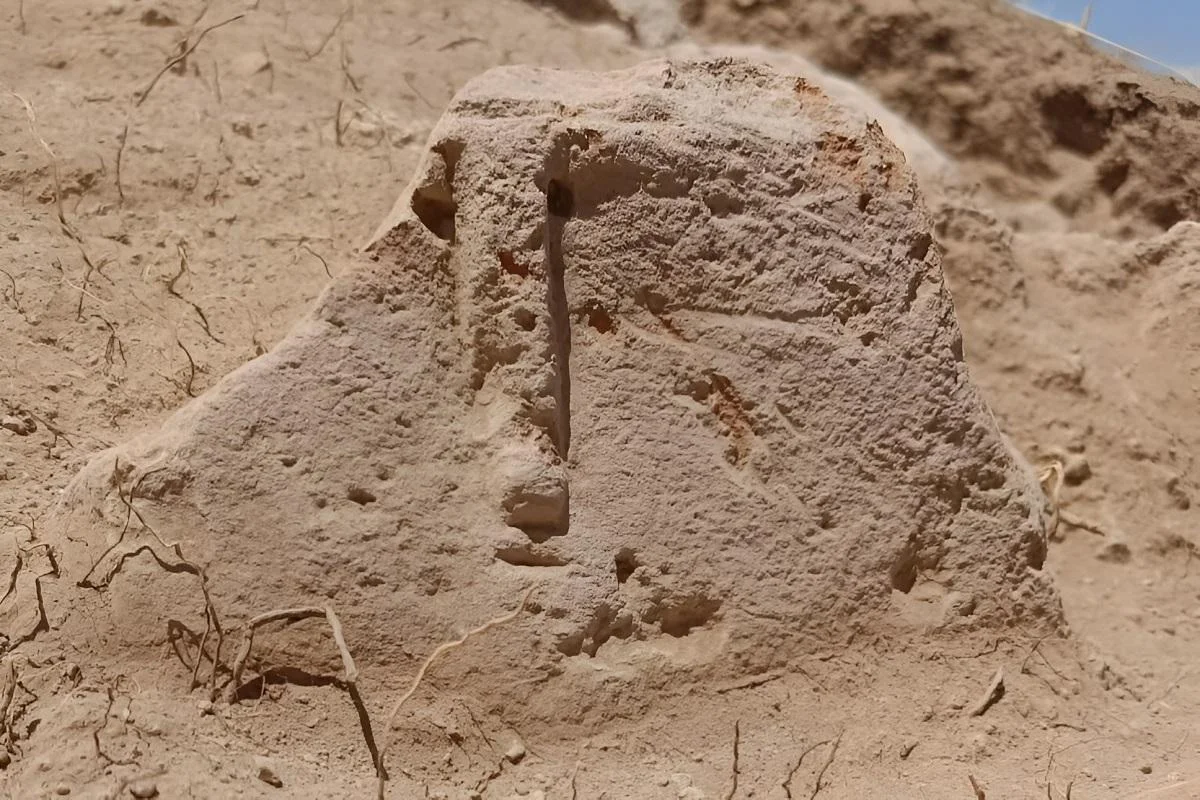A joint team of Armenian and Polish archaeologists has discovered a 2,500-year-old stone idol bearing a human face at the ruins of the ancient Urartian fortress-city of Argishtikhinili, located atop Surb Davti Blur Hill (Saint David’s Hill) in Armenia’s Armavir Province. This was reported by Heritage Daily, Archaeology Magazine, Popular Mechanics, and Arkeonews.
The excavations—part of a renewed Armenian-Polish archaeological project—were led by Dr. Mateusz Iskra of the Polish Centre of Mediterranean Archaeology (University of Warsaw) and Hasmik Simonyan of the Institute of Archaeology and Ethnography (National Academy of Sciences of Armenia), with support from the Cultural Heritage Protection and Museum Reserves Service.
The joint project aims to reconstruct daily life, environmental changes, and the urban decline of Argishtikhinili between the 8th and 6th centuries BCE.
Founded in 774 BCE by King Argishti I, Argishtikhinili served as one of Urartu’s key administrative and economic hubs—not merely a military fortress—overseeing the fertile Ararat Plain. Saint David’s Hill is one of the site’s two major mounds, and the latest discoveries there reveal new dimensions of daily life, ritual practice, and resilience in this ancient highland city.
As reported earlier in 2025 by Zartonk Media, the first excavation season (conducted in late 2024) uncovered 6th-century BCE residential houses with walls nearly 1.5 meters thick, a cremation cemetery, and geological evidence of a powerful earthquake that likely contributed to the site’s decline. The ongoing second season of excavations has now revealed one of the most intriguing artifacts yet—a human-faced idol preserved in situ within a sealed chamber.
A Mysterious Human-Faced Idol
Within one of the excavated rooms—part of a late 7th to 6th century BCE residential complex—archaeologists uncovered a buried masonry (stone) chest. Inside or immediately against the chest in situ lay a stone slab carved with a human face, remarkably preserved in its original context.
Carved from volcanic tuff, the idol measures between ~0.5 and 1 meter tall (?1.6–3.3 ft), with pronounced eyebrows, closely set eyes, a long nose, and narrow lips. Despite its stylized form, the expression appears strikingly human. Researchers emphasize that it may depict a deity, ancestor, or symbolic protector—possibly linked to fertility or ancestral cults documented at other Armenian sites—but its true identity and purpose remain unconfirmed.
“The idol figure is preserved in its original context,” said Dr. Iskra, noting that its placement within a sealed chamber makes it a rare undisturbed example of Urartian ritual art.
The stone chest may have contained organic offerings. Laboratory analyses are underway to detect traces of wine, oils, plant extracts, or other ceremonial substances—similar to residues found in Egypt’s Bes mugs—which could clarify the idol’s function, symbolism, and ritual association, and even indicate whether it represented a local “fortress deity.” Because no Urartian temples survive, scholars often rely on Assyrian reliefs from the same era to infer sacred interiors; in Urartu, gods were also depicted on storeroom walls, so the room where the idol was found may once have been painted with the image of the deity it represented.
Excavations at Saint David’s Hill
The dig exposed large terraced houses dating to the late 7th and 6th centuries BCE, with intact mudbrick and stone-slab floors. One ground-floor section measured roughly 400 m², pointing to elite residences. Dr. Iskra underscored that these were residential, not fortification walls, and described domestic and storage quarters that included large ceramic vessels embedded in the floor—a detail that illuminates provisioning and household organization during the kingdom’s decline.
Cremation Cemetery and Earthquake Evidence
Archaeologists also uncovered a cremation urnfield cemetery containing twelve burials, each accompanied by grave goods and ornaments. Ashes and remnants of funeral pyres were placed in urns sealed with shallow dishes, then set into rock niches and covered with soil. Despite signs of illegal looting—broken urns and scattered fragments likely disturbed by metal detectorists—several intact vessels were recovered, including one urn covered with a stamped dish, preliminarily dated to the first half of the 7th century BCE. The site’s preservation makes it one of Armenia’s most significant and best-preserved urnfield cemeteries.
A geological team led by Prof. Barbara Woronko (University of Warsaw) documented fault lines characteristic of a major earthquake, a powerful seismic event that may have damaged or ended occupation at Davti Blur. Its exact date remains under investigation.
The Urartian Pantheon and Cultural Context
The Kingdom of Urartu (9th–6th centuries BCE) revered at least 79 deities, whose names and sacrifices were inscribed in a mountain niche near Tushpa (modern-day Van). Among them were Haldi (war and kingship), Teisheba (storms and thunder), and Shivini (the sun god, whose winged solar disk may reflect influence from Egypt’s Ra).
If analyses of the chest’s contents reveal organic substances corresponding to those ancient sacrificial lists, the idol could be tied to a specific cult or local divinity—illustrating how administrative, domestic, and spiritual life were intertwined in Urartu and hinting at a “fortress deity” for Argishtikhinili.
Preservation and Future Research
Archaeologists describe the discoveries as exceptional, both for their preservation and their potential to reconstruct Urartian domestic, ritual, and funerary life.
The team has also warned that modern dumping, looting, and cemetery expansion continue to threaten the site’s preservation.
The renewed Armenian-Polish excavations resumed in late 2024, followed by a second field season in May–June 2025, with a third phase planned for 2026 to expand mapping and explore how residents adapted to environmental and political change. Project co-director Hasmik Simonyan emphasized plans to transform Davti Blur into a public archaeological reserve, combining heritage tourism with educational outreach. Artifacts from the site will also be catalogued and exhibited in collaboration with the Sardarabad Ethnographic Museum.
A Window into Urartian Armenia
From the human-faced idol resting silently in its chest to the urns of the cremation cemetery and the earthquake-damaged homes of Argishtikhinili, these discoveries reveal a society balancing daily life, faith, and mortality at the twilight of the Urartian Kingdom. As laboratory analyses continue, researchers hope to decipher the deeper meanings behind these finds—perhaps, as Popular Mechanics put it, “to finally see the face of a forgotten god.”


